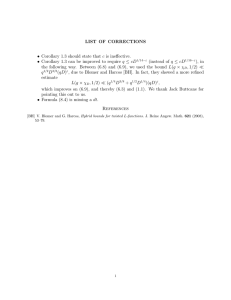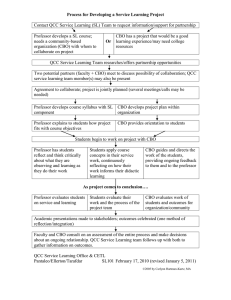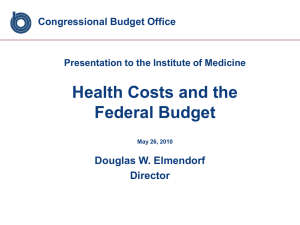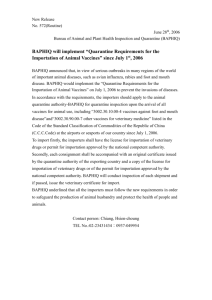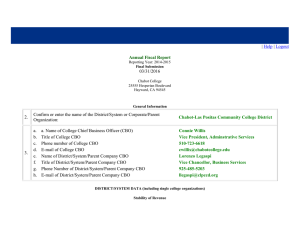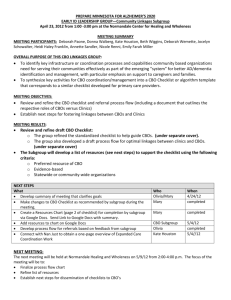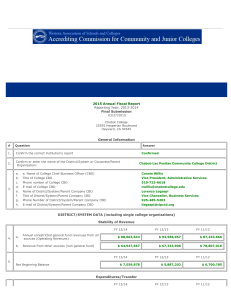CBO ANALYSIS OF SAVINGS FROM PRESCRIPTION DRUG IMPORTATION Colin Baker Margaret Nowak
advertisement
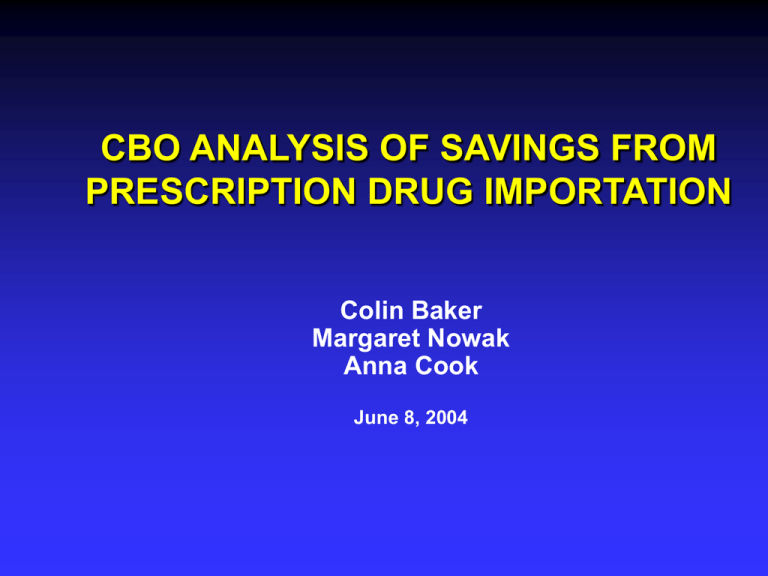
CBO ANALYSIS OF SAVINGS FROM PRESCRIPTION DRUG IMPORTATION Colin Baker Margaret Nowak Anna Cook June 8, 2004 Overview Discuss estimated savings from drug importation under the Medicare Modernization Act and H.R. 2427 Explain CBO’s methodology for estimating savings from drug importation Summarize factors leading to small estimated savings from drug importation to date Drug Importation Under the Medicare Modernization Act Previously, a drug could be imported into the U.S. only by its manufacturer The Medicare Act (MMA) allows importation from Canada only, certification by the Secretary of HHS CBO estimated savings to the federal government of less than $50 million over 10 years under MMA drug after Drug Importation under H.R. 2427 Would permit drug importation industrialized countries from 25 CBO estimated total U.S. drug spending would fall by $40 billion (1%) over 10 years Federal direct spending would fall by $2.9 billion (about 0.5%) Federal spending falls by a lower amount in percentage terms – many federal programs already get low prices. Steps for Estimating Savings Estimate average price differences between the U.S. and source countries Account for importers’ costs (re-packaging, liability insurance) Calculate the potential supply from source countries relative to the U.S. market Consider actions by manufacturers, FDA, and foreign governments that may limit supply Considerations in Making International Price Comparisons Which U.S. drug prices do you use? Should both generic and brand-name drugs be included? How well can drug products across countries be matched? How is the price comparison weighted? International Price Differences CBO concluded manufacturer prices of patented brand-name drugs average about 35 to 55 percent less in other industrialized countries, relative to the U.S. That range is based partly on international price comparisons of patented brand-name drugs by Canada’s PMPRB Danzon and Furukawa (2003) found that prices on patented products ranged from 26% lower in the UK to 49% lower in France and Italy. Parallel Trade CBO looked to the European experience in parallel trade Parallel trade is the legal movement of products across borders without the explicit consent of the manufacturer Parallel trade within the EU is facilitated by a single regulatory body that can be used for drug approvals (EMEA) as well as favorable EU court decisions Sizing the Market The volume of world supply outside the U.S. is about twice the size of the U.S. market. About 5 to 6 percent of the volume in low priced countries is traded to higher priced countries within Europe If parallel trade were as free of impediments as it is in Europe today, such trade could supply about 10% to 15% of the U.S. market Restrictions on Supply FDA: Imported drugs must be manufactured in an FDA inspected facility and meet labeling standards Manufacturers: limit supply through contracts with wholesalers; shift production away from FDA inspected facilities Foreign governments could restrict exports to U.S. (if supply shortages occur or if manufacturers threaten to raise prices) Estimated Savings Given supply restrictions, much less than 10 to 15% of the U.S. market would be supplied through parallel trade under current proposals Price differences must also account for intermediary costs – liability insurance, repackaging and relabelling Overall, under H.R. 2427, CBO estimated that U.S. drug spending would fall by 1%, federal spending by 0.5% Conclusion Limitations on supply have played a key role in CBO’s estimates of drug importation to date. Savings from importation will vary by purchaser type (different purchasers pay different prices in the U.S.) CBO is currently evaluating importation proposals new drug Conclusion CBO Issue Brief on drug importation and cost estimate of H.R. 2427 available at: www.cbo.gov

